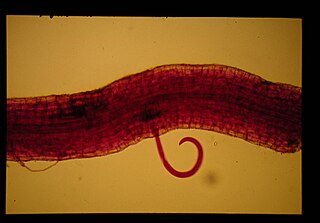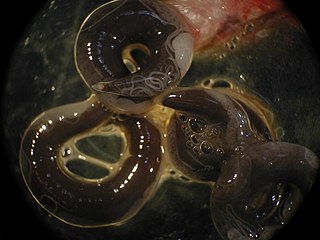Galls or cecidia are a kind of swelling growth on the external tissues of plants. Plant galls are abnormal outgrowths of plant tissues, similar to benign tumors or warts in animals. They can be caused by various parasites, from viruses, fungi and bacteria, to other plants, insects and mites. Plant galls are often highly organized structures so that the cause of the gall can often be determined without the actual agent being identified. This applies particularly to insect and mite plant galls. The study of plant galls is known as cecidology.
Northern root-knot nematode is a species of vegetable pathogens which produces tiny galls on around 550 crop and weed species. They invade root tissue after birth. Females are able to lay up to 1,000 eggs at a time in a large egg mass. By surviving harsh winters, they can survive in cold climates.

Enoplea (enopleans) is a class, which with the classes Secernentea and Chromadorea make up the phylum Nematoda in current taxonomy. The Enoplea are considered to be a more ancestral group than the Chromadorea, and researchers have referred to its members as the "ancestrally diverged nematodes", compared to the "more recently diverged nematodes" of Chromadorea.

Root-knot nematodes are plant-parasitic nematodes from the genus Meloidogyne. They exist in soil in areas with hot climates or short winters. About 2000 plants worldwide are susceptible to infection by root-knot nematodes and they cause approximately 5% of global crop loss. Root-knot nematode larvae infect plant roots, causing the development of root-knot galls that drain the plant's photosynthate and nutrients. Infection of young plants may be lethal, while infection of mature plants causes decreased yield.

Major sperm protein (MSP) is a nematode specific small protein of 126 amino acids with a molecular weight of 14 kDa. It is the key player in the motility machinery of nematodes that propels the crawling movement/motility of nematode sperm. It is the most abundant protein present in nematode sperm, comprising 15% of the total protein and more than 40% of the soluble protein. MSP is exclusively synthesized in spermatocytes of the nematodes. The MSP has two main functions in the reproduction of the helminthes: i) as cytosolic component it is responsible for the crawling movement of the mature sperm, and ii) once released, it acts as hormone on the female germ cells, where it triggers oocyte maturation and stimulates the oviduct wall to contract to bring the oocytes into position for fertilization. MSP has first been identified in Caenorhabditis elegans.

The Chromadorea are a class of the roundworm phylum, Nematoda. They contain a single subclass (Chromadoria) and several orders. With such a redundant arrangement, the Chromadoria are liable to be divided if the orders are found to form several clades, or abandoned if they are found to constitute a single radiation.

Pratylenchus penetrans is a species of nematode in the genus Pratylenchus, the lesion nematodes. It occurs in temperate regions worldwide, regions between the subtropics and the polar circles. It is an animal that inhabits the roots of a wide variety of plants and results in necrotic lesions on the roots. Symptoms of P. penetrans make it hard to distinguish from other plant pathogens; only an assay of soil can conclusively diagnose a nematode problem in the field. P. penetrans is physically very similar to other nematode species, but is characterized by its highly distinctive mouthpiece. P. penetrans uses its highly modified mouth organs to rupture the outer surface of subterranean plant root structures. It will then enter into the root interior and feed on the plant tissue inside. P. penetrans is considered to be a crop parasite and farmers will often treat their soil with various pesticides in an attempt to eliminate the damage caused by an infestation. In doing this, farmers will also eliminate many of the beneficial soil fauna, which will lead to an overall degradation of soil quality in the future. Alternative, more environmentally sustainable methods to control P. penetrans populations may be possible in certain regions.
Pratylenchus vulnus is a species of plant pathogenic nematode best known for infecting Persian walnut. It is also known to infest potatoes, apricots, peaches and nectarines, holiday cacti, grape and citruses.

Helicotylenchus dihystera is a plant pathogenic nematode. It is known to inhabit sugarcane, rice, potatoes, corn, peanut, millet, sorghum, banana and forest trees.
Xiphinema diversicaudatum is an amphimictic ectoparasitic nematode species. This species has a characteristically long stylet capable of penetrating into a host's vascular tissue. They have a wide host range with some of the extensively studied ones being strawberry, hops and raspberry, due to their economic importance. The direct root damage caused through penetration near the root tip and formation of galls is a secondary concern when compared with the damage caused by vectoring the Arabis mosaic virus. The virus attaches to the interior cuticle lining and can be transferred from infected to uninfected root tissue as the nematode feeds and sheds. Management of this particular nematode relies on nematicides such as 1,3-Dichloropropene (Telone) at 40 gpa.or methyl bromide at 1000 lb/ac to control to 28 in deep.

Nematology is the scientific discipline concerned with the study of nematodes, or roundworms. Although nematological investigation dates back to the days of Aristotle or even earlier, nematology as an independent discipline has its recognizable beginnings in the mid to late 19th century.

Pratylenchus is a genus of nematodes known commonly as lesion nematodes. They are parasitic on plants and are responsible for root lesion disease on many taxa of host plants in temperate regions around the world. Lesion nematodes are migratory endoparasites that feed and reproduce in the root and move around, unlike the cyst or root-knot nematodes, which may stay in one place. They usually only feed on the cortex of the root. Species are distinguished primarily by the morphology of the stylets.
Tylenchorhynchus is a genus of nematodes including many species of plant parasites. The classification of stunt nematodes - those including the genus Tylenchorhynchus - is unstable; many newly discovered species within this genus are reconsidered to be actually subspecies. Stunt nematodes such as Tylenchorhynchus and the closely related genera, Anguillulina and Merlinia, include more than 250 known species. Members of these genera possess similar anatomy and may be easily mistaken for one another. Some debate has led to the classification of single species under different names in two distinct genera.

The nematodes, roundworms or eelworms constitute the phylum Nematoda. They are a diverse animal phylum inhabiting a broad range of environments. Most species are free-living, feeding on microorganisms, but there are many that are parasitic. The parasitic worms (helminths) are the cause of soil-transmitted helminthiases.

A nematode infection is a type of helminthiasis caused by organisms in the nematode phylum.
The red ring disease of coconuts and African oil palms is caused by the nematode Bursaphelenchus cocophilus. It is also identified in literature with an alternative scientific name Rhadinaphelenchus cocophilus. The common name, the red ring nematode, is derived from its distinguishing symptom.

Anthelmintics or antihelminthics are a group of antiparasitic drugs that expel parasitic worms (helminths) and other internal parasites from the body by either stunning or killing them and without causing significant damage to the host. They may also be called vermifuges or vermicides. Anthelmintics are used to treat people who are infected by helminths, a condition called helminthiasis. These drugs are also used to treat infected animals.

Purpureocillium lilacinum is a species of filamentous fungus in the family Ophiocordycipitaceae. It has been isolated from a wide range of habitats, including cultivated and uncultivated soils, forests, grassland, deserts, estuarine sediments and sewage sludge, and insects. It has also been found in nematode eggs, and occasionally from females of root-knot and cyst nematodes. In addition, it has frequently been detected in the rhizosphere of many crops. The species can grow at a wide range of temperatures – from 8 to 38 °C for a few isolates, with optimal growth in the range 26 to 30 °C. It also has a wide pH tolerance and can grow on a variety of substrates. P. lilacinum has shown promising results for use as a biocontrol agent to control the growth of destructive root-knot nematodes.

Anguillicoloides is a genus of nematodes belonging to the family Dracunculidae.











